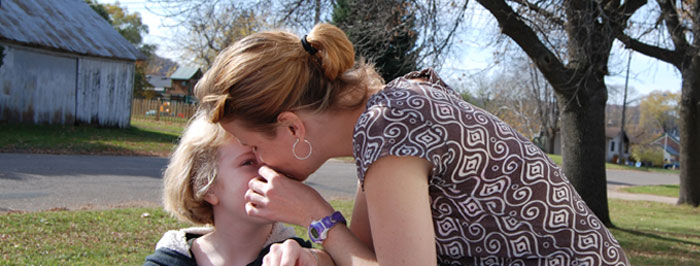One Woman’s Journey of Survival, a Revolution at a Crossroads
With the recent US economic collapse, domestic violence statistics show a sharp increase in violence against women around the country. States are closing shelters and cutting programs. Yet the mainstream media ignores domestic violence, except when there are celebrity incidents, (OJ, Rihanna, Charlie Sheen, Mel Gibson, etc etc etc). In the meantime, more spouses have been killed by their partners in the past several years than soldiers have been killed in Iraq.
“Power and Control” is a documentary film that addresses a life and death issue during a time of urgent crisis. The film is a timely and comprehensive exploration of physical and emotional abuse in our society, as refracted through the story of Kim Mosher, a Duluth, MN mother of three.
In the summer of 2008, Kim, 30, packed her daughters into her PT Cruiser and left her abusive husband. She had sworn she would never do it; she would hang on to the marriage at any cost. But now that her husband was yelling at the kids and hitting them, there was no choice. So she drove away from 10 years of emotional and physical abuse in her home in Wabasha, MN and headed for Duluth.
Kim was lucky enough to find a welcoming embrace at the Safe Haven battered women’s shelter, where she recovered from the difficult final weeks leading up to her escape. Her strength and inner resources were instantly apparent
Kim’s stoic Minnesota grit and sense of humor carry her through. Life in the shelter isn’t easy. Holding down a job at McDonalds job, shuttling her daughters to day care and searching for housing pose a daunting challenge. Yet Kim still somehow finds the time to bond with her sister domestic violence victims, forming friendships that will last beyond her stay at Safe Haven.

Then Kim faces another difficult test — to go back to the house she shared with her husband, one last time. Driving three hours with her oldest daughter Dakotah in the back seat, Kim chain smokes Newports and professes little fear of her husband or her in-laws, who live next door.
Twenty-four hours later, Kim pulls up in front of her new home in West Duluth, finally safe.
Kim’s journey is at the heart of “Power and Control.” Her story serves as a powerful reminder of progress we’ve made — and of the major reforms still needed in policing, medical care, advocacy and in the fundamental cultural and social institutions that perpetuate the cycle.
And there’s a final twist to the story. Several months after we thought we had finished filming, Kim called to report that she had gotten back with her husband. We returned to film Kim, her husband Josh and the three girls. Problems and tension had already emerged. The next step in Kim’s journey is now uncertain. Her story has no clean and simple ending.
And that, we feel, has added new depth and complexity to the message of the film.
The Revolution in Domestic Violence Policy
Duluth, and the influential ideas that emanated from the rugged port city are the film’s second “character.” In the early 1980s, social activists Ellen Pence and Michael Paymar founded the Domestic Abuse Intervention Project, which this year celebrate its 30th anniversary. They became the leading innovators of domestic violence policy — successfully implementing a mandatory arrest policy, a “coordinated community response” to domestic violence and a treatment program for batterers. They also developed the “Power and Control” wheel, the graphic representation of domestic violence relationships that has been translated into 40 languages and has become the ubiquitous symbol of the battered women’s movement.
We interview Pence and Paymar, profiling Pence, a charismatic social activist who is still on the front line of the domestic violence movement. From this, the film’s second strand emerges, a dynamic, fast paced history of the battered women’s movement, an overview of the “Duluth Model,” mandatory arrest as it’s practiced by cops on the beat, and a frank portrayal of batterers in a DAIP men’s group.
Not surprisingly, 30 years after its inception the Duluth model faces many critics. The debate about the future of domestic violence policy forms the film’s third major strand.
Within the battered women’s movement, provocative new questions are being asked. Founders, many still in leadership positions, question if the idea of sisterhood and the commitment to social change has been squashed by bureaucracy..
On the outside, a new “post-feminist” viewpoint challenges the movement’s sacred principles. For advocates, the viewpoint represents a dangerous backlash, raising the prospect of undoing the achievements of the past decades.
Somewhere within this passionately contentious debate, there is a consensus emerging that certain new approaches may be worth trying. Within the battered women’s movement, innovators are experimenting with “restorative justice” and other methods. Others are pressing for institutional change aimed at prevention — in the schools, the workplace, religious institutions and the medical system.
